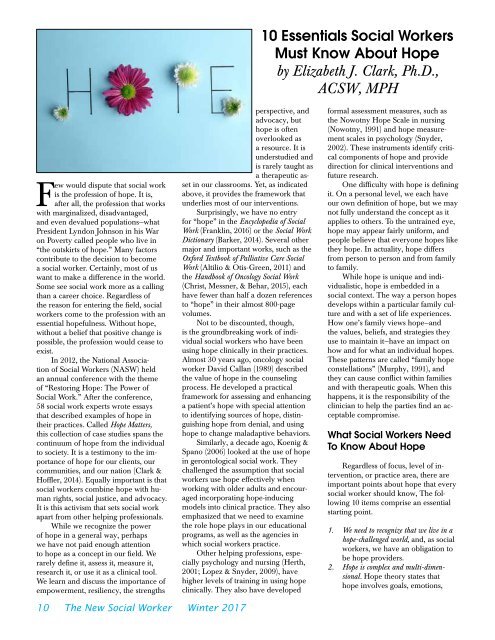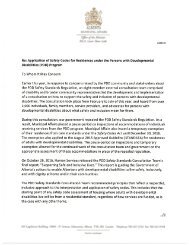In This Issue
click
click
You also want an ePaper? Increase the reach of your titles
YUMPU automatically turns print PDFs into web optimized ePapers that Google loves.
10 Essentials Social Workers<br />
Must Know About Hope<br />
by Elizabeth J. Clark, Ph.D.,<br />
ACSW, MPH<br />
Few would dispute that social work<br />
is the profession of hope. It is,<br />
after all, the profession that works<br />
with marginalized, disadvantaged,<br />
and even devalued populations—what<br />
President Lyndon Johnson in his War<br />
on Poverty called people who live in<br />
“the outskirts of hope.” Many factors<br />
contribute to the decision to become<br />
a social worker. Certainly, most of us<br />
want to make a difference in the world.<br />
Some see social work more as a calling<br />
than a career choice. Regardless of<br />
the reason for entering the field, social<br />
workers come to the profession with an<br />
essential hopefulness. Without hope,<br />
without a belief that positive change is<br />
possible, the profession would cease to<br />
exist.<br />
<strong>In</strong> 2012, the National Association<br />
of Social Workers (NASW) held<br />
an annual conference with the theme<br />
of “Restoring Hope: The Power of<br />
Social Work.” After the conference,<br />
58 social work experts wrote essays<br />
that described examples of hope in<br />
their practices. Called Hope Matters,<br />
this collection of case studies spans the<br />
continuum of hope from the individual<br />
to society. It is a testimony to the importance<br />
of hope for our clients, our<br />
communities, and our nation (Clark &<br />
Hoffler, 2014). Equally important is that<br />
social workers combine hope with human<br />
rights, social justice, and advocacy.<br />
It is this activism that sets social work<br />
apart from other helping professionals.<br />
While we recognize the power<br />
of hope in a general way, perhaps<br />
we have not paid enough attention<br />
to hope as a concept in our field. We<br />
rarely define it, assess it, measure it,<br />
research it, or use it as a clinical tool.<br />
We learn and discuss the importance of<br />
empowerment, resiliency, the strengths<br />
perspective, and<br />
advocacy, but<br />
hope is often<br />
overlooked as<br />
a resource. It is<br />
understudied and<br />
is rarely taught as<br />
a therapeutic asset<br />
in our classrooms. Yet, as indicated<br />
above, it provides the framework that<br />
underlies most of our interventions.<br />
Surprisingly, we have no entry<br />
for “hope” in the Encyclopedia of Social<br />
Work (Franklin, 2016) or the Social Work<br />
Dictionary (Barker, 2014). Several other<br />
major and important works, such as the<br />
Oxford Textbook of Palliative Care Social<br />
Work (Altilio & Otis-Green, 2011) and<br />
the Handbook of Oncology Social Work<br />
(Christ, Messner, & Behar, 2015), each<br />
have fewer than half a dozen references<br />
to “hope” in their almost 800-page<br />
volumes.<br />
Not to be discounted, though,<br />
is the groundbreaking work of individual<br />
social workers who have been<br />
using hope clinically in their practices.<br />
Almost 30 years ago, oncology social<br />
worker David Callan (1989) described<br />
the value of hope in the counseling<br />
process. He developed a practical<br />
framework for assessing and enhancing<br />
a patient’s hope with special attention<br />
to identifying sources of hope, distinguishing<br />
hope from denial, and using<br />
hope to change maladaptive behaviors.<br />
Similarly, a decade ago, Koenig &<br />
Spano (2006) looked at the use of hope<br />
in gerontological social work. They<br />
challenged the assumption that social<br />
workers use hope effectively when<br />
working with older adults and encouraged<br />
incorporating hope-inducing<br />
models into clinical practice. They also<br />
emphasized that we need to examine<br />
the role hope plays in our educational<br />
programs, as well as the agencies in<br />
which social workers practice.<br />
Other helping professions, especially<br />
psychology and nursing (Herth,<br />
2001; Lopez & Snyder, 2009), have<br />
higher levels of training in using hope<br />
clinically. They also have developed<br />
formal assessment measures, such as<br />
the Nowotny Hope Scale in nursing<br />
(Nowotny, 1991) and hope measurement<br />
scales in psychology (Snyder,<br />
2002). These instruments identify critical<br />
components of hope and provide<br />
direction for clinical interventions and<br />
future research.<br />
One difficulty with hope is defining<br />
it. On a personal level, we each have<br />
our own definition of hope, but we may<br />
not fully understand the concept as it<br />
applies to others. To the untrained eye,<br />
hope may appear fairly uniform, and<br />
people believe that everyone hopes like<br />
they hope. <strong>In</strong> actuality, hope differs<br />
from person to person and from family<br />
to family.<br />
While hope is unique and individualistic,<br />
hope is embedded in a<br />
social context. The way a person hopes<br />
develops within a particular family culture<br />
and with a set of life experiences.<br />
How one’s family views hope—and<br />
the values, beliefs, and strategies they<br />
use to maintain it—have an impact on<br />
how and for what an individual hopes.<br />
These patterns are called “family hope<br />
constellations” (Murphy, 1991), and<br />
they can cause conflict within families<br />
and with therapeutic goals. When this<br />
happens, it is the responsibility of the<br />
clinician to help the parties find an acceptable<br />
compromise.<br />
What Social Workers Need<br />
To Know About Hope<br />
Regardless of focus, level of intervention,<br />
or practice area, there are<br />
important points about hope that every<br />
social worker should know, The following<br />
10 items comprise an essential<br />
starting point.<br />
1. We need to recognize that we live in a<br />
hope-challenged world, and, as social<br />
workers, we have an obligation to<br />
be hope providers.<br />
2. Hope is complex and multi-dimensional.<br />
Hope theory states that<br />
hope involves goals, emotions,<br />
10 The New Social Worker Winter 2017




